Auditing and Assurance - Assignment
VerifiedAdded on 2021/06/15
|14
|3741
|18
AI Summary
Contribute Materials
Your contribution can guide someone’s learning journey. Share your
documents today.
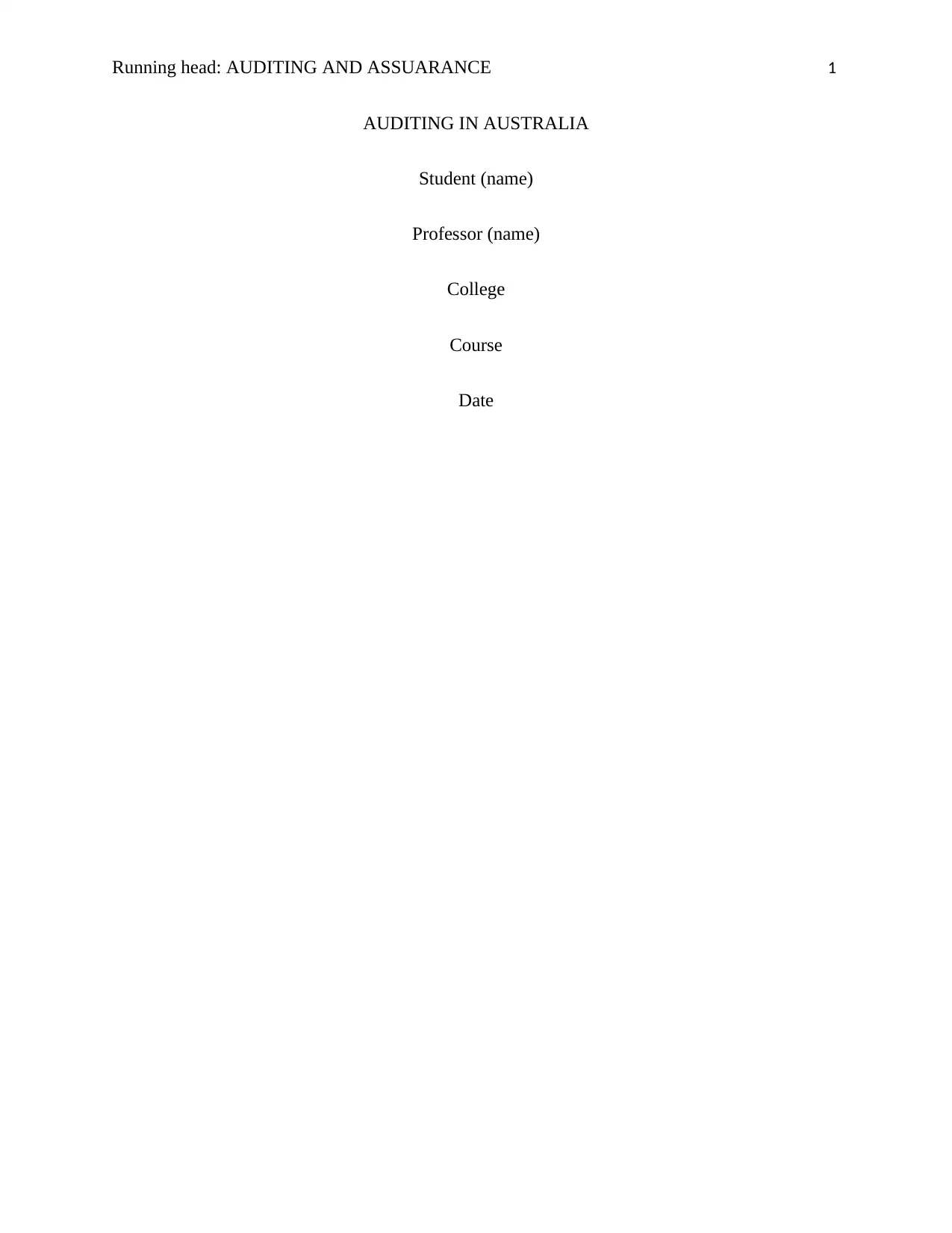
Running head: AUDITING AND ASSUARANCE 1
AUDITING IN AUSTRALIA
Student (name)
Professor (name)
College
Course
Date
AUDITING IN AUSTRALIA
Student (name)
Professor (name)
College
Course
Date
Secure Best Marks with AI Grader
Need help grading? Try our AI Grader for instant feedback on your assignments.
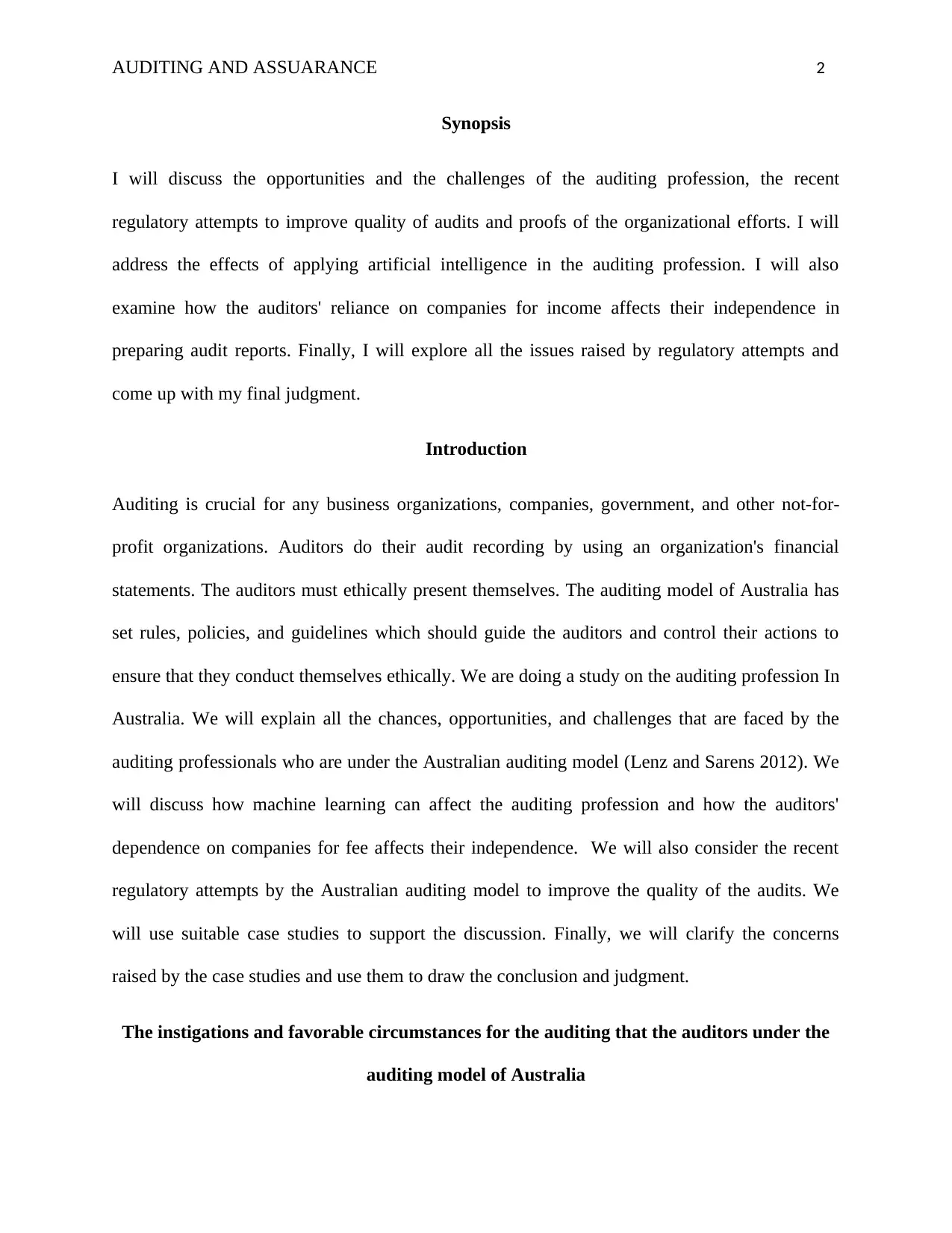
AUDITING AND ASSUARANCE 2
Synopsis
I will discuss the opportunities and the challenges of the auditing profession, the recent
regulatory attempts to improve quality of audits and proofs of the organizational efforts. I will
address the effects of applying artificial intelligence in the auditing profession. I will also
examine how the auditors' reliance on companies for income affects their independence in
preparing audit reports. Finally, I will explore all the issues raised by regulatory attempts and
come up with my final judgment.
Introduction
Auditing is crucial for any business organizations, companies, government, and other not-for-
profit organizations. Auditors do their audit recording by using an organization's financial
statements. The auditors must ethically present themselves. The auditing model of Australia has
set rules, policies, and guidelines which should guide the auditors and control their actions to
ensure that they conduct themselves ethically. We are doing a study on the auditing profession In
Australia. We will explain all the chances, opportunities, and challenges that are faced by the
auditing professionals who are under the Australian auditing model (Lenz and Sarens 2012). We
will discuss how machine learning can affect the auditing profession and how the auditors'
dependence on companies for fee affects their independence. We will also consider the recent
regulatory attempts by the Australian auditing model to improve the quality of the audits. We
will use suitable case studies to support the discussion. Finally, we will clarify the concerns
raised by the case studies and use them to draw the conclusion and judgment.
The instigations and favorable circumstances for the auditing that the auditors under the
auditing model of Australia
Synopsis
I will discuss the opportunities and the challenges of the auditing profession, the recent
regulatory attempts to improve quality of audits and proofs of the organizational efforts. I will
address the effects of applying artificial intelligence in the auditing profession. I will also
examine how the auditors' reliance on companies for income affects their independence in
preparing audit reports. Finally, I will explore all the issues raised by regulatory attempts and
come up with my final judgment.
Introduction
Auditing is crucial for any business organizations, companies, government, and other not-for-
profit organizations. Auditors do their audit recording by using an organization's financial
statements. The auditors must ethically present themselves. The auditing model of Australia has
set rules, policies, and guidelines which should guide the auditors and control their actions to
ensure that they conduct themselves ethically. We are doing a study on the auditing profession In
Australia. We will explain all the chances, opportunities, and challenges that are faced by the
auditing professionals who are under the Australian auditing model (Lenz and Sarens 2012). We
will discuss how machine learning can affect the auditing profession and how the auditors'
dependence on companies for fee affects their independence. We will also consider the recent
regulatory attempts by the Australian auditing model to improve the quality of the audits. We
will use suitable case studies to support the discussion. Finally, we will clarify the concerns
raised by the case studies and use them to draw the conclusion and judgment.
The instigations and favorable circumstances for the auditing that the auditors under the
auditing model of Australia
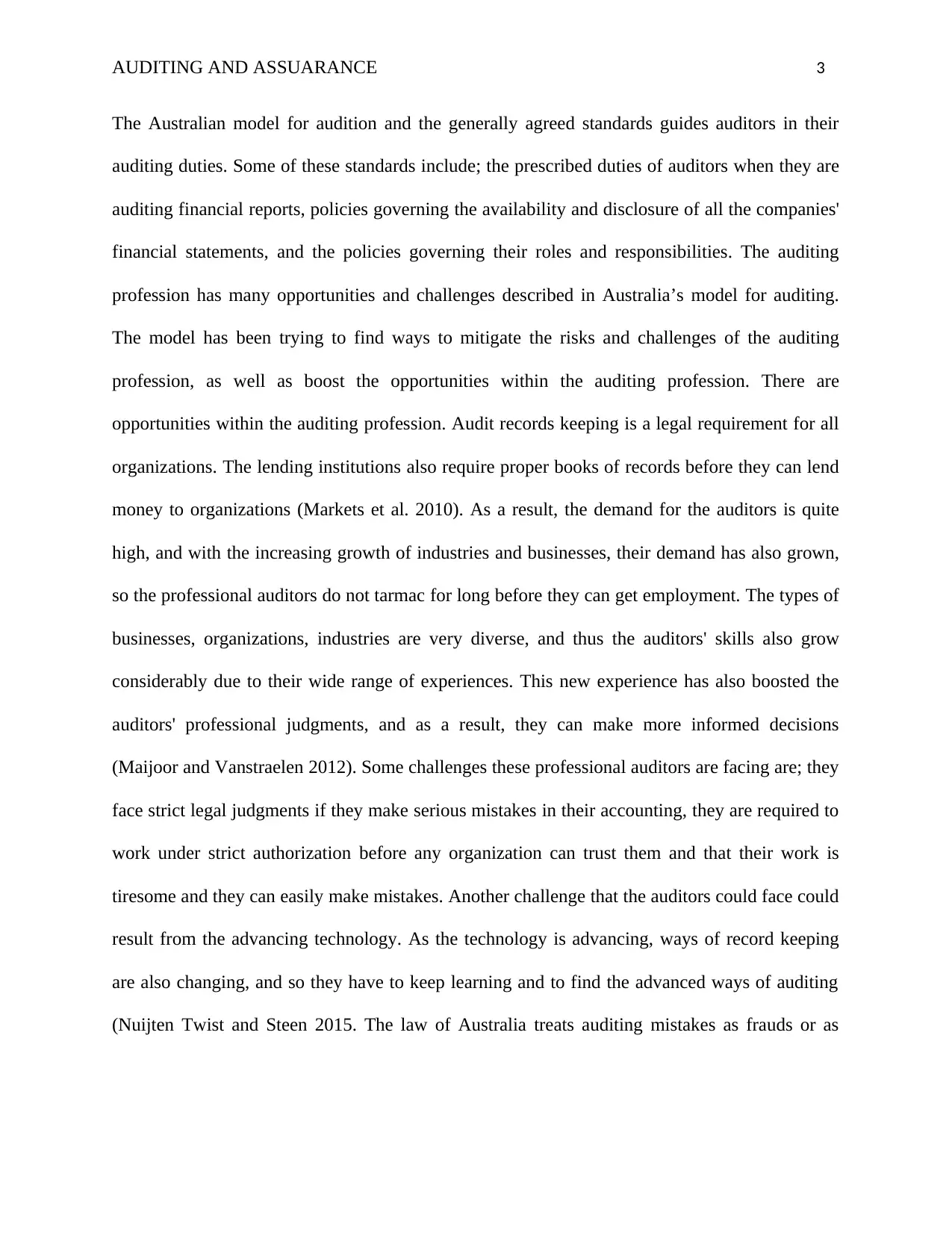
AUDITING AND ASSUARANCE 3
The Australian model for audition and the generally agreed standards guides auditors in their
auditing duties. Some of these standards include; the prescribed duties of auditors when they are
auditing financial reports, policies governing the availability and disclosure of all the companies'
financial statements, and the policies governing their roles and responsibilities. The auditing
profession has many opportunities and challenges described in Australia’s model for auditing.
The model has been trying to find ways to mitigate the risks and challenges of the auditing
profession, as well as boost the opportunities within the auditing profession. There are
opportunities within the auditing profession. Audit records keeping is a legal requirement for all
organizations. The lending institutions also require proper books of records before they can lend
money to organizations (Markets et al. 2010). As a result, the demand for the auditors is quite
high, and with the increasing growth of industries and businesses, their demand has also grown,
so the professional auditors do not tarmac for long before they can get employment. The types of
businesses, organizations, industries are very diverse, and thus the auditors' skills also grow
considerably due to their wide range of experiences. This new experience has also boosted the
auditors' professional judgments, and as a result, they can make more informed decisions
(Maijoor and Vanstraelen 2012). Some challenges these professional auditors are facing are; they
face strict legal judgments if they make serious mistakes in their accounting, they are required to
work under strict authorization before any organization can trust them and that their work is
tiresome and they can easily make mistakes. Another challenge that the auditors could face could
result from the advancing technology. As the technology is advancing, ways of record keeping
are also changing, and so they have to keep learning and to find the advanced ways of auditing
(Nuijten Twist and Steen 2015. The law of Australia treats auditing mistakes as frauds or as
The Australian model for audition and the generally agreed standards guides auditors in their
auditing duties. Some of these standards include; the prescribed duties of auditors when they are
auditing financial reports, policies governing the availability and disclosure of all the companies'
financial statements, and the policies governing their roles and responsibilities. The auditing
profession has many opportunities and challenges described in Australia’s model for auditing.
The model has been trying to find ways to mitigate the risks and challenges of the auditing
profession, as well as boost the opportunities within the auditing profession. There are
opportunities within the auditing profession. Audit records keeping is a legal requirement for all
organizations. The lending institutions also require proper books of records before they can lend
money to organizations (Markets et al. 2010). As a result, the demand for the auditors is quite
high, and with the increasing growth of industries and businesses, their demand has also grown,
so the professional auditors do not tarmac for long before they can get employment. The types of
businesses, organizations, industries are very diverse, and thus the auditors' skills also grow
considerably due to their wide range of experiences. This new experience has also boosted the
auditors' professional judgments, and as a result, they can make more informed decisions
(Maijoor and Vanstraelen 2012). Some challenges these professional auditors are facing are; they
face strict legal judgments if they make serious mistakes in their accounting, they are required to
work under strict authorization before any organization can trust them and that their work is
tiresome and they can easily make mistakes. Another challenge that the auditors could face could
result from the advancing technology. As the technology is advancing, ways of record keeping
are also changing, and so they have to keep learning and to find the advanced ways of auditing
(Nuijten Twist and Steen 2015. The law of Australia treats auditing mistakes as frauds or as
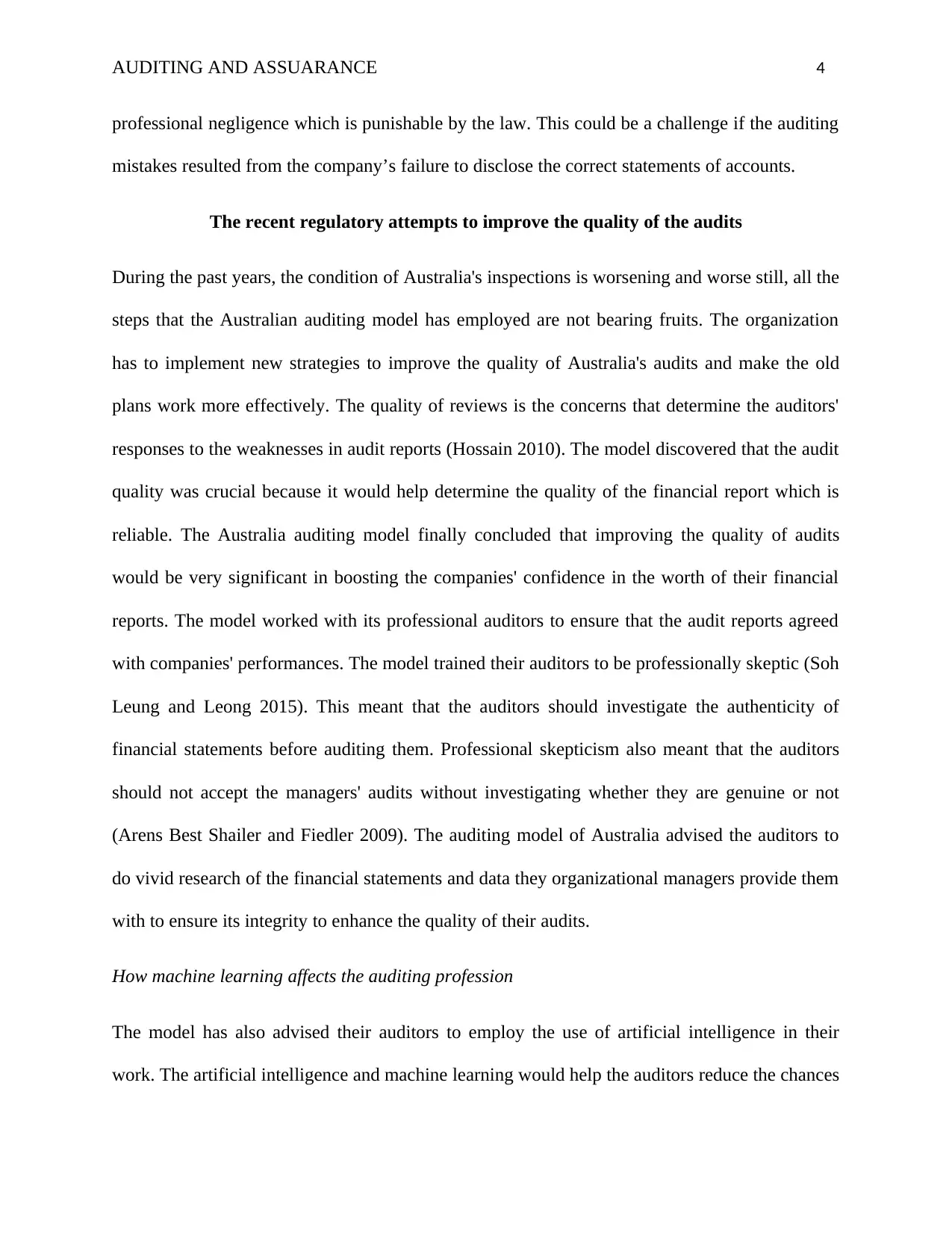
AUDITING AND ASSUARANCE 4
professional negligence which is punishable by the law. This could be a challenge if the auditing
mistakes resulted from the company’s failure to disclose the correct statements of accounts.
The recent regulatory attempts to improve the quality of the audits
During the past years, the condition of Australia's inspections is worsening and worse still, all the
steps that the Australian auditing model has employed are not bearing fruits. The organization
has to implement new strategies to improve the quality of Australia's audits and make the old
plans work more effectively. The quality of reviews is the concerns that determine the auditors'
responses to the weaknesses in audit reports (Hossain 2010). The model discovered that the audit
quality was crucial because it would help determine the quality of the financial report which is
reliable. The Australia auditing model finally concluded that improving the quality of audits
would be very significant in boosting the companies' confidence in the worth of their financial
reports. The model worked with its professional auditors to ensure that the audit reports agreed
with companies' performances. The model trained their auditors to be professionally skeptic (Soh
Leung and Leong 2015). This meant that the auditors should investigate the authenticity of
financial statements before auditing them. Professional skepticism also meant that the auditors
should not accept the managers' audits without investigating whether they are genuine or not
(Arens Best Shailer and Fiedler 2009). The auditing model of Australia advised the auditors to
do vivid research of the financial statements and data they organizational managers provide them
with to ensure its integrity to enhance the quality of their audits.
How machine learning affects the auditing profession
The model has also advised their auditors to employ the use of artificial intelligence in their
work. The artificial intelligence and machine learning would help the auditors reduce the chances
professional negligence which is punishable by the law. This could be a challenge if the auditing
mistakes resulted from the company’s failure to disclose the correct statements of accounts.
The recent regulatory attempts to improve the quality of the audits
During the past years, the condition of Australia's inspections is worsening and worse still, all the
steps that the Australian auditing model has employed are not bearing fruits. The organization
has to implement new strategies to improve the quality of Australia's audits and make the old
plans work more effectively. The quality of reviews is the concerns that determine the auditors'
responses to the weaknesses in audit reports (Hossain 2010). The model discovered that the audit
quality was crucial because it would help determine the quality of the financial report which is
reliable. The Australia auditing model finally concluded that improving the quality of audits
would be very significant in boosting the companies' confidence in the worth of their financial
reports. The model worked with its professional auditors to ensure that the audit reports agreed
with companies' performances. The model trained their auditors to be professionally skeptic (Soh
Leung and Leong 2015). This meant that the auditors should investigate the authenticity of
financial statements before auditing them. Professional skepticism also meant that the auditors
should not accept the managers' audits without investigating whether they are genuine or not
(Arens Best Shailer and Fiedler 2009). The auditing model of Australia advised the auditors to
do vivid research of the financial statements and data they organizational managers provide them
with to ensure its integrity to enhance the quality of their audits.
How machine learning affects the auditing profession
The model has also advised their auditors to employ the use of artificial intelligence in their
work. The artificial intelligence and machine learning would help the auditors reduce the chances
Secure Best Marks with AI Grader
Need help grading? Try our AI Grader for instant feedback on your assignments.
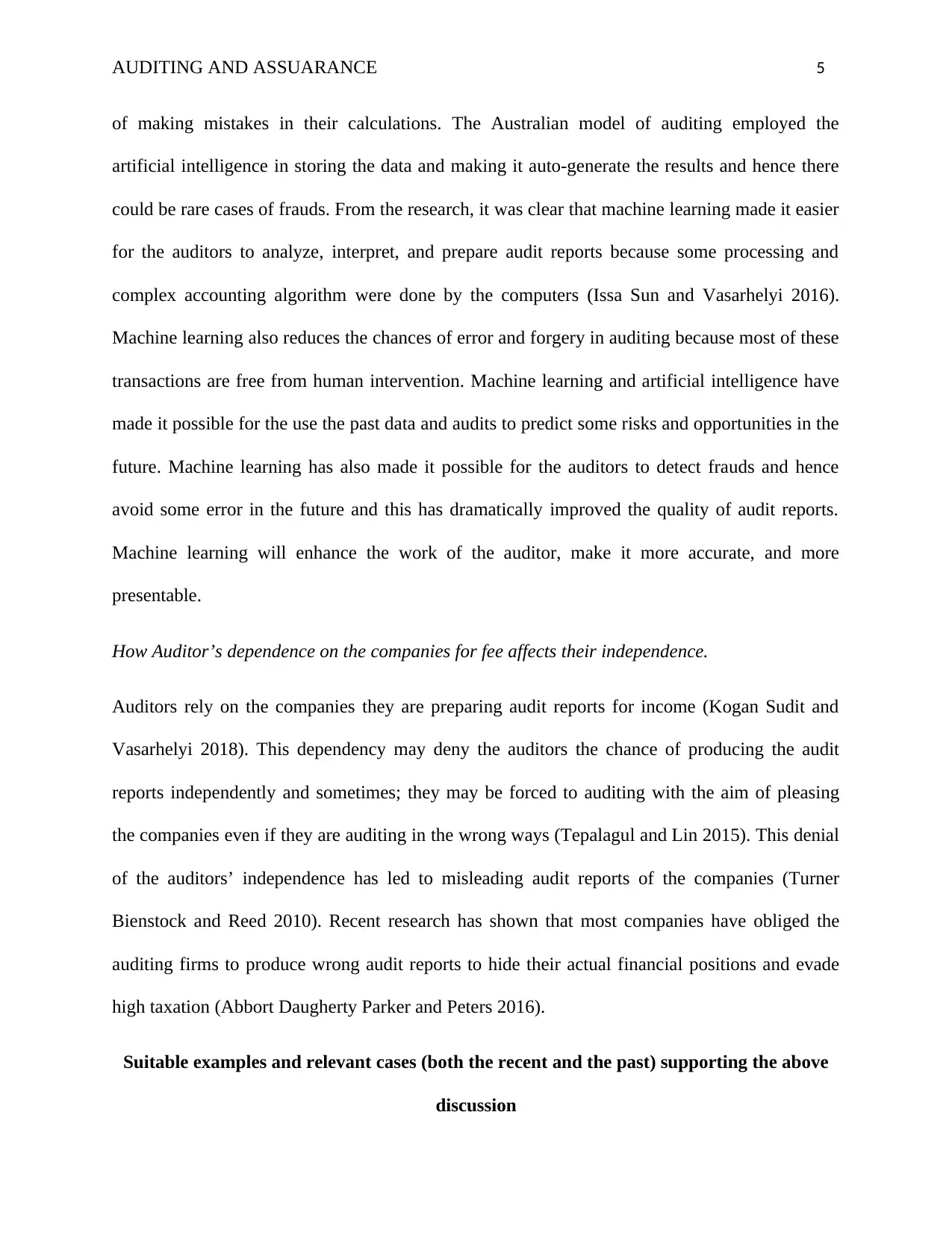
AUDITING AND ASSUARANCE 5
of making mistakes in their calculations. The Australian model of auditing employed the
artificial intelligence in storing the data and making it auto-generate the results and hence there
could be rare cases of frauds. From the research, it was clear that machine learning made it easier
for the auditors to analyze, interpret, and prepare audit reports because some processing and
complex accounting algorithm were done by the computers (Issa Sun and Vasarhelyi 2016).
Machine learning also reduces the chances of error and forgery in auditing because most of these
transactions are free from human intervention. Machine learning and artificial intelligence have
made it possible for the use the past data and audits to predict some risks and opportunities in the
future. Machine learning has also made it possible for the auditors to detect frauds and hence
avoid some error in the future and this has dramatically improved the quality of audit reports.
Machine learning will enhance the work of the auditor, make it more accurate, and more
presentable.
How Auditor’s dependence on the companies for fee affects their independence.
Auditors rely on the companies they are preparing audit reports for income (Kogan Sudit and
Vasarhelyi 2018). This dependency may deny the auditors the chance of producing the audit
reports independently and sometimes; they may be forced to auditing with the aim of pleasing
the companies even if they are auditing in the wrong ways (Tepalagul and Lin 2015). This denial
of the auditors’ independence has led to misleading audit reports of the companies (Turner
Bienstock and Reed 2010). Recent research has shown that most companies have obliged the
auditing firms to produce wrong audit reports to hide their actual financial positions and evade
high taxation (Abbort Daugherty Parker and Peters 2016).
Suitable examples and relevant cases (both the recent and the past) supporting the above
discussion
of making mistakes in their calculations. The Australian model of auditing employed the
artificial intelligence in storing the data and making it auto-generate the results and hence there
could be rare cases of frauds. From the research, it was clear that machine learning made it easier
for the auditors to analyze, interpret, and prepare audit reports because some processing and
complex accounting algorithm were done by the computers (Issa Sun and Vasarhelyi 2016).
Machine learning also reduces the chances of error and forgery in auditing because most of these
transactions are free from human intervention. Machine learning and artificial intelligence have
made it possible for the use the past data and audits to predict some risks and opportunities in the
future. Machine learning has also made it possible for the auditors to detect frauds and hence
avoid some error in the future and this has dramatically improved the quality of audit reports.
Machine learning will enhance the work of the auditor, make it more accurate, and more
presentable.
How Auditor’s dependence on the companies for fee affects their independence.
Auditors rely on the companies they are preparing audit reports for income (Kogan Sudit and
Vasarhelyi 2018). This dependency may deny the auditors the chance of producing the audit
reports independently and sometimes; they may be forced to auditing with the aim of pleasing
the companies even if they are auditing in the wrong ways (Tepalagul and Lin 2015). This denial
of the auditors’ independence has led to misleading audit reports of the companies (Turner
Bienstock and Reed 2010). Recent research has shown that most companies have obliged the
auditing firms to produce wrong audit reports to hide their actual financial positions and evade
high taxation (Abbort Daugherty Parker and Peters 2016).
Suitable examples and relevant cases (both the recent and the past) supporting the above
discussion
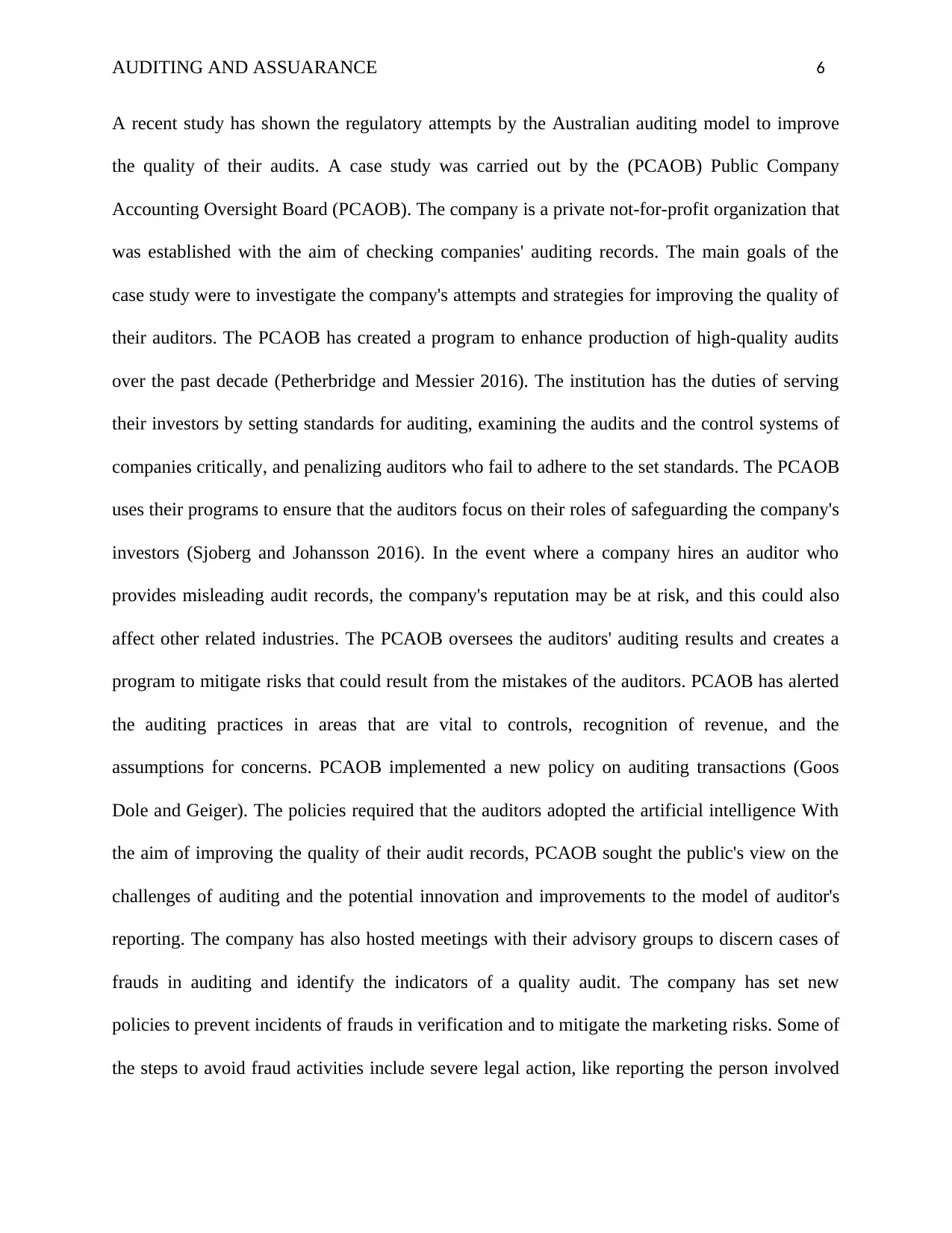
AUDITING AND ASSUARANCE 6
A recent study has shown the regulatory attempts by the Australian auditing model to improve
the quality of their audits. A case study was carried out by the (PCAOB) Public Company
Accounting Oversight Board (PCAOB). The company is a private not-for-profit organization that
was established with the aim of checking companies' auditing records. The main goals of the
case study were to investigate the company's attempts and strategies for improving the quality of
their auditors. The PCAOB has created a program to enhance production of high-quality audits
over the past decade (Petherbridge and Messier 2016). The institution has the duties of serving
their investors by setting standards for auditing, examining the audits and the control systems of
companies critically, and penalizing auditors who fail to adhere to the set standards. The PCAOB
uses their programs to ensure that the auditors focus on their roles of safeguarding the company's
investors (Sjoberg and Johansson 2016). In the event where a company hires an auditor who
provides misleading audit records, the company's reputation may be at risk, and this could also
affect other related industries. The PCAOB oversees the auditors' auditing results and creates a
program to mitigate risks that could result from the mistakes of the auditors. PCAOB has alerted
the auditing practices in areas that are vital to controls, recognition of revenue, and the
assumptions for concerns. PCAOB implemented a new policy on auditing transactions (Goos
Dole and Geiger). The policies required that the auditors adopted the artificial intelligence With
the aim of improving the quality of their audit records, PCAOB sought the public's view on the
challenges of auditing and the potential innovation and improvements to the model of auditor's
reporting. The company has also hosted meetings with their advisory groups to discern cases of
frauds in auditing and identify the indicators of a quality audit. The company has set new
policies to prevent incidents of frauds in verification and to mitigate the marketing risks. Some of
the steps to avoid fraud activities include severe legal action, like reporting the person involved
A recent study has shown the regulatory attempts by the Australian auditing model to improve
the quality of their audits. A case study was carried out by the (PCAOB) Public Company
Accounting Oversight Board (PCAOB). The company is a private not-for-profit organization that
was established with the aim of checking companies' auditing records. The main goals of the
case study were to investigate the company's attempts and strategies for improving the quality of
their auditors. The PCAOB has created a program to enhance production of high-quality audits
over the past decade (Petherbridge and Messier 2016). The institution has the duties of serving
their investors by setting standards for auditing, examining the audits and the control systems of
companies critically, and penalizing auditors who fail to adhere to the set standards. The PCAOB
uses their programs to ensure that the auditors focus on their roles of safeguarding the company's
investors (Sjoberg and Johansson 2016). In the event where a company hires an auditor who
provides misleading audit records, the company's reputation may be at risk, and this could also
affect other related industries. The PCAOB oversees the auditors' auditing results and creates a
program to mitigate risks that could result from the mistakes of the auditors. PCAOB has alerted
the auditing practices in areas that are vital to controls, recognition of revenue, and the
assumptions for concerns. PCAOB implemented a new policy on auditing transactions (Goos
Dole and Geiger). The policies required that the auditors adopted the artificial intelligence With
the aim of improving the quality of their audit records, PCAOB sought the public's view on the
challenges of auditing and the potential innovation and improvements to the model of auditor's
reporting. The company has also hosted meetings with their advisory groups to discern cases of
frauds in auditing and identify the indicators of a quality audit. The company has set new
policies to prevent incidents of frauds in verification and to mitigate the marketing risks. Some of
the steps to avoid fraud activities include severe legal action, like reporting the person involved
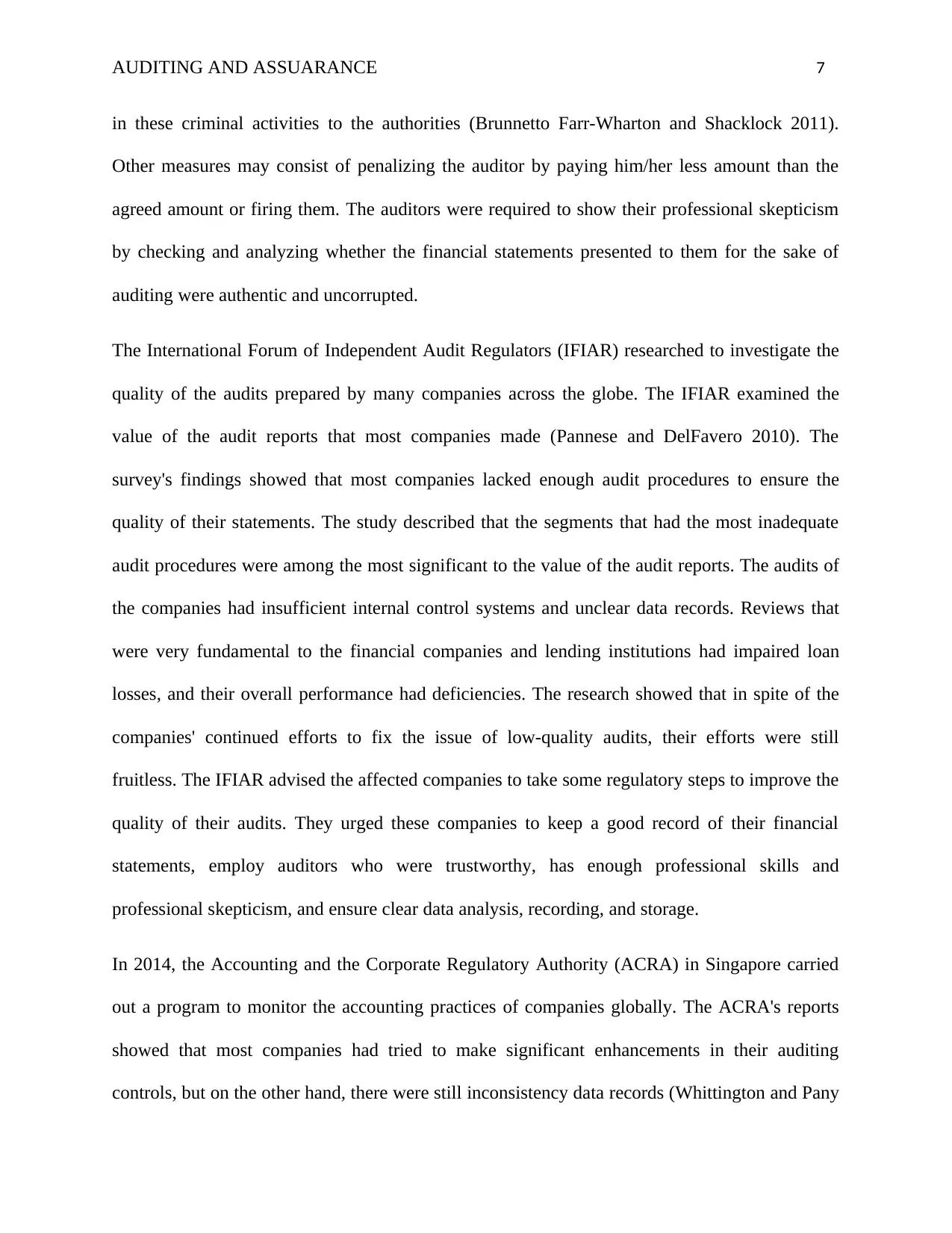
AUDITING AND ASSUARANCE 7
in these criminal activities to the authorities (Brunnetto Farr-Wharton and Shacklock 2011).
Other measures may consist of penalizing the auditor by paying him/her less amount than the
agreed amount or firing them. The auditors were required to show their professional skepticism
by checking and analyzing whether the financial statements presented to them for the sake of
auditing were authentic and uncorrupted.
The International Forum of Independent Audit Regulators (IFIAR) researched to investigate the
quality of the audits prepared by many companies across the globe. The IFIAR examined the
value of the audit reports that most companies made (Pannese and DelFavero 2010). The
survey's findings showed that most companies lacked enough audit procedures to ensure the
quality of their statements. The study described that the segments that had the most inadequate
audit procedures were among the most significant to the value of the audit reports. The audits of
the companies had insufficient internal control systems and unclear data records. Reviews that
were very fundamental to the financial companies and lending institutions had impaired loan
losses, and their overall performance had deficiencies. The research showed that in spite of the
companies' continued efforts to fix the issue of low-quality audits, their efforts were still
fruitless. The IFIAR advised the affected companies to take some regulatory steps to improve the
quality of their audits. They urged these companies to keep a good record of their financial
statements, employ auditors who were trustworthy, has enough professional skills and
professional skepticism, and ensure clear data analysis, recording, and storage.
In 2014, the Accounting and the Corporate Regulatory Authority (ACRA) in Singapore carried
out a program to monitor the accounting practices of companies globally. The ACRA's reports
showed that most companies had tried to make significant enhancements in their auditing
controls, but on the other hand, there were still inconsistency data records (Whittington and Pany
in these criminal activities to the authorities (Brunnetto Farr-Wharton and Shacklock 2011).
Other measures may consist of penalizing the auditor by paying him/her less amount than the
agreed amount or firing them. The auditors were required to show their professional skepticism
by checking and analyzing whether the financial statements presented to them for the sake of
auditing were authentic and uncorrupted.
The International Forum of Independent Audit Regulators (IFIAR) researched to investigate the
quality of the audits prepared by many companies across the globe. The IFIAR examined the
value of the audit reports that most companies made (Pannese and DelFavero 2010). The
survey's findings showed that most companies lacked enough audit procedures to ensure the
quality of their statements. The study described that the segments that had the most inadequate
audit procedures were among the most significant to the value of the audit reports. The audits of
the companies had insufficient internal control systems and unclear data records. Reviews that
were very fundamental to the financial companies and lending institutions had impaired loan
losses, and their overall performance had deficiencies. The research showed that in spite of the
companies' continued efforts to fix the issue of low-quality audits, their efforts were still
fruitless. The IFIAR advised the affected companies to take some regulatory steps to improve the
quality of their audits. They urged these companies to keep a good record of their financial
statements, employ auditors who were trustworthy, has enough professional skills and
professional skepticism, and ensure clear data analysis, recording, and storage.
In 2014, the Accounting and the Corporate Regulatory Authority (ACRA) in Singapore carried
out a program to monitor the accounting practices of companies globally. The ACRA's reports
showed that most companies had tried to make significant enhancements in their auditing
controls, but on the other hand, there were still inconsistency data records (Whittington and Pany
Paraphrase This Document
Need a fresh take? Get an instant paraphrase of this document with our AI Paraphraser
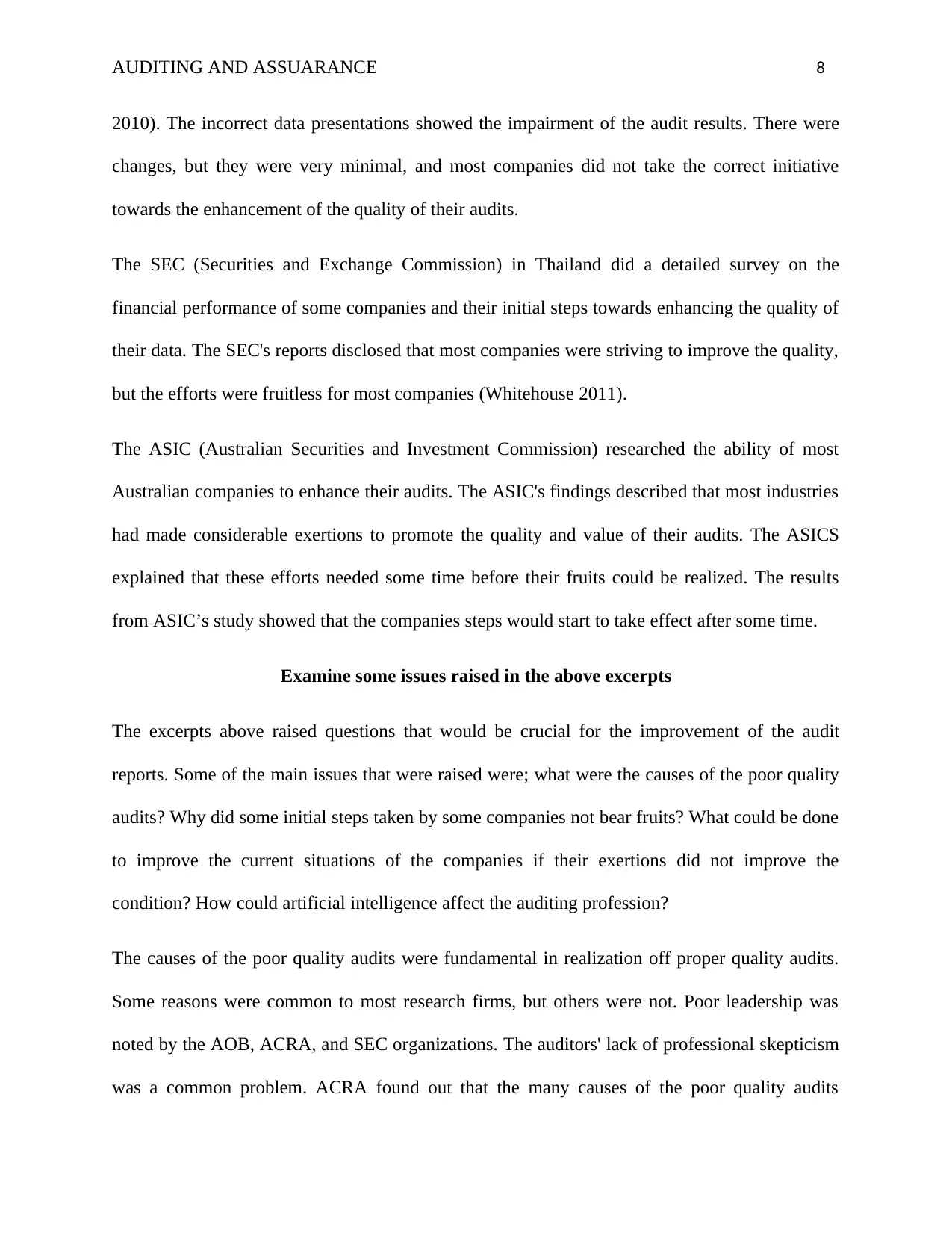
AUDITING AND ASSUARANCE 8
2010). The incorrect data presentations showed the impairment of the audit results. There were
changes, but they were very minimal, and most companies did not take the correct initiative
towards the enhancement of the quality of their audits.
The SEC (Securities and Exchange Commission) in Thailand did a detailed survey on the
financial performance of some companies and their initial steps towards enhancing the quality of
their data. The SEC's reports disclosed that most companies were striving to improve the quality,
but the efforts were fruitless for most companies (Whitehouse 2011).
The ASIC (Australian Securities and Investment Commission) researched the ability of most
Australian companies to enhance their audits. The ASIC's findings described that most industries
had made considerable exertions to promote the quality and value of their audits. The ASICS
explained that these efforts needed some time before their fruits could be realized. The results
from ASIC’s study showed that the companies steps would start to take effect after some time.
Examine some issues raised in the above excerpts
The excerpts above raised questions that would be crucial for the improvement of the audit
reports. Some of the main issues that were raised were; what were the causes of the poor quality
audits? Why did some initial steps taken by some companies not bear fruits? What could be done
to improve the current situations of the companies if their exertions did not improve the
condition? How could artificial intelligence affect the auditing profession?
The causes of the poor quality audits were fundamental in realization off proper quality audits.
Some reasons were common to most research firms, but others were not. Poor leadership was
noted by the AOB, ACRA, and SEC organizations. The auditors' lack of professional skepticism
was a common problem. ACRA found out that the many causes of the poor quality audits
2010). The incorrect data presentations showed the impairment of the audit results. There were
changes, but they were very minimal, and most companies did not take the correct initiative
towards the enhancement of the quality of their audits.
The SEC (Securities and Exchange Commission) in Thailand did a detailed survey on the
financial performance of some companies and their initial steps towards enhancing the quality of
their data. The SEC's reports disclosed that most companies were striving to improve the quality,
but the efforts were fruitless for most companies (Whitehouse 2011).
The ASIC (Australian Securities and Investment Commission) researched the ability of most
Australian companies to enhance their audits. The ASIC's findings described that most industries
had made considerable exertions to promote the quality and value of their audits. The ASICS
explained that these efforts needed some time before their fruits could be realized. The results
from ASIC’s study showed that the companies steps would start to take effect after some time.
Examine some issues raised in the above excerpts
The excerpts above raised questions that would be crucial for the improvement of the audit
reports. Some of the main issues that were raised were; what were the causes of the poor quality
audits? Why did some initial steps taken by some companies not bear fruits? What could be done
to improve the current situations of the companies if their exertions did not improve the
condition? How could artificial intelligence affect the auditing profession?
The causes of the poor quality audits were fundamental in realization off proper quality audits.
Some reasons were common to most research firms, but others were not. Poor leadership was
noted by the AOB, ACRA, and SEC organizations. The auditors' lack of professional skepticism
was a common problem. ACRA found out that the many causes of the poor quality audits
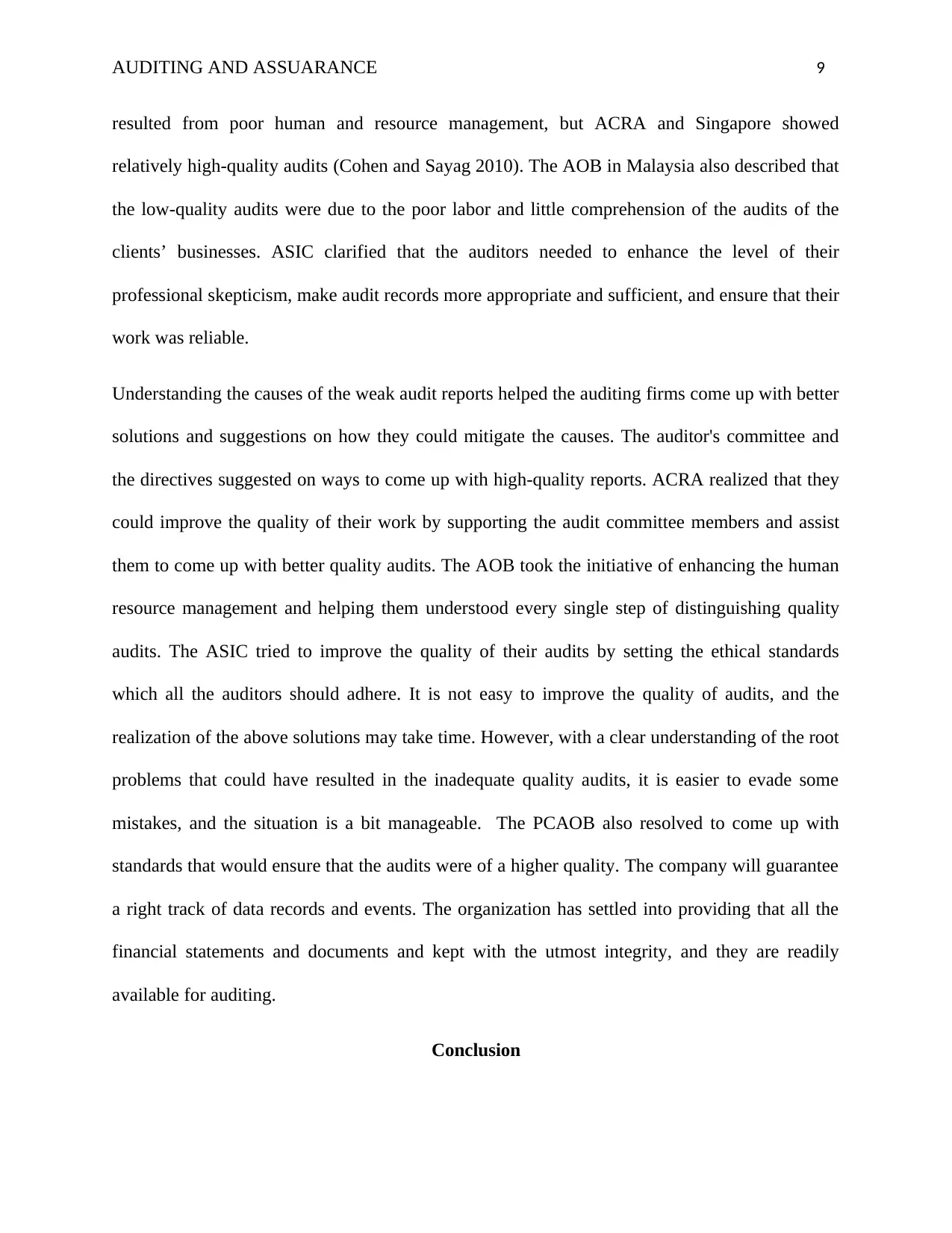
AUDITING AND ASSUARANCE 9
resulted from poor human and resource management, but ACRA and Singapore showed
relatively high-quality audits (Cohen and Sayag 2010). The AOB in Malaysia also described that
the low-quality audits were due to the poor labor and little comprehension of the audits of the
clients’ businesses. ASIC clarified that the auditors needed to enhance the level of their
professional skepticism, make audit records more appropriate and sufficient, and ensure that their
work was reliable.
Understanding the causes of the weak audit reports helped the auditing firms come up with better
solutions and suggestions on how they could mitigate the causes. The auditor's committee and
the directives suggested on ways to come up with high-quality reports. ACRA realized that they
could improve the quality of their work by supporting the audit committee members and assist
them to come up with better quality audits. The AOB took the initiative of enhancing the human
resource management and helping them understood every single step of distinguishing quality
audits. The ASIC tried to improve the quality of their audits by setting the ethical standards
which all the auditors should adhere. It is not easy to improve the quality of audits, and the
realization of the above solutions may take time. However, with a clear understanding of the root
problems that could have resulted in the inadequate quality audits, it is easier to evade some
mistakes, and the situation is a bit manageable. The PCAOB also resolved to come up with
standards that would ensure that the audits were of a higher quality. The company will guarantee
a right track of data records and events. The organization has settled into providing that all the
financial statements and documents and kept with the utmost integrity, and they are readily
available for auditing.
Conclusion
resulted from poor human and resource management, but ACRA and Singapore showed
relatively high-quality audits (Cohen and Sayag 2010). The AOB in Malaysia also described that
the low-quality audits were due to the poor labor and little comprehension of the audits of the
clients’ businesses. ASIC clarified that the auditors needed to enhance the level of their
professional skepticism, make audit records more appropriate and sufficient, and ensure that their
work was reliable.
Understanding the causes of the weak audit reports helped the auditing firms come up with better
solutions and suggestions on how they could mitigate the causes. The auditor's committee and
the directives suggested on ways to come up with high-quality reports. ACRA realized that they
could improve the quality of their work by supporting the audit committee members and assist
them to come up with better quality audits. The AOB took the initiative of enhancing the human
resource management and helping them understood every single step of distinguishing quality
audits. The ASIC tried to improve the quality of their audits by setting the ethical standards
which all the auditors should adhere. It is not easy to improve the quality of audits, and the
realization of the above solutions may take time. However, with a clear understanding of the root
problems that could have resulted in the inadequate quality audits, it is easier to evade some
mistakes, and the situation is a bit manageable. The PCAOB also resolved to come up with
standards that would ensure that the audits were of a higher quality. The company will guarantee
a right track of data records and events. The organization has settled into providing that all the
financial statements and documents and kept with the utmost integrity, and they are readily
available for auditing.
Conclusion
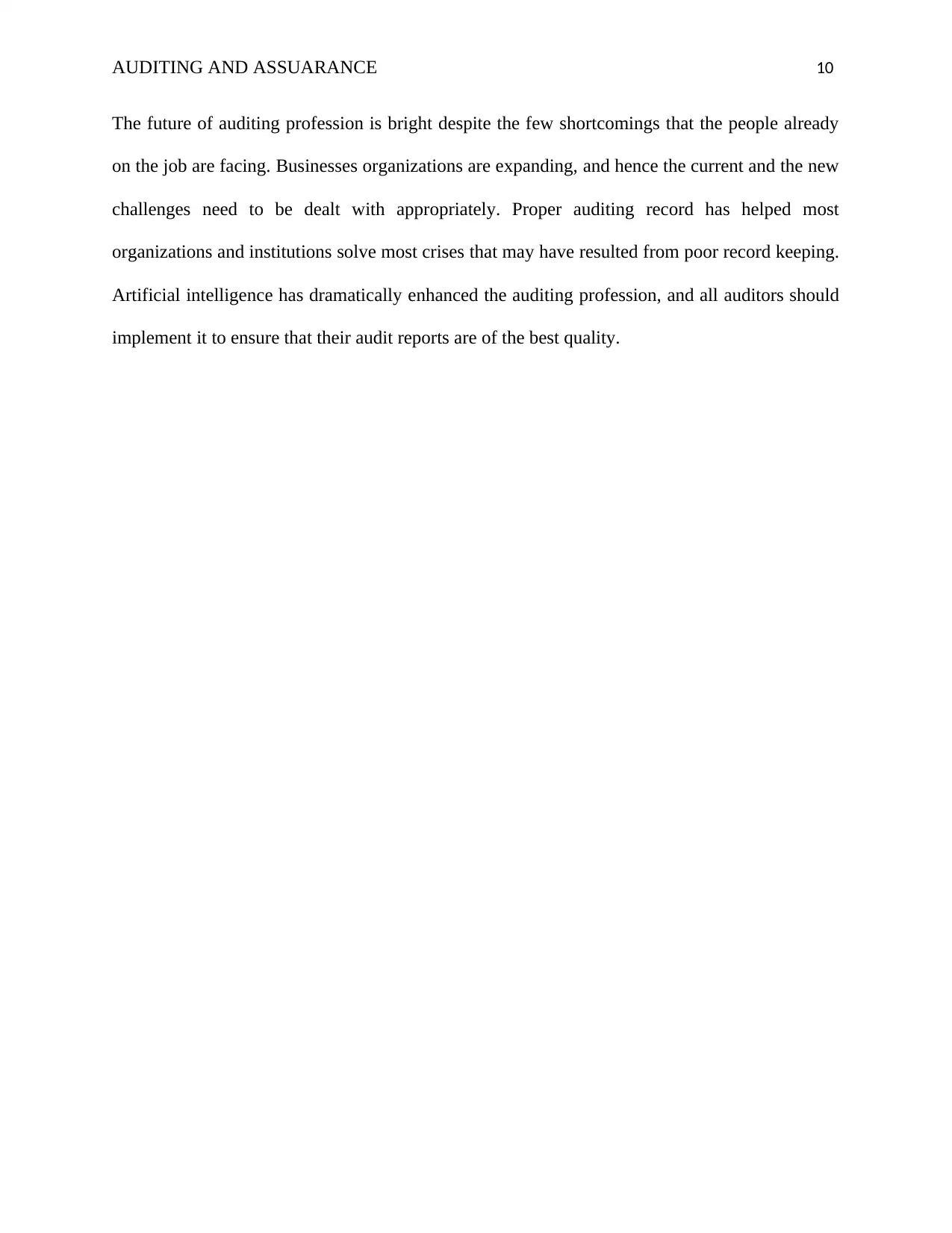
AUDITING AND ASSUARANCE 10
The future of auditing profession is bright despite the few shortcomings that the people already
on the job are facing. Businesses organizations are expanding, and hence the current and the new
challenges need to be dealt with appropriately. Proper auditing record has helped most
organizations and institutions solve most crises that may have resulted from poor record keeping.
Artificial intelligence has dramatically enhanced the auditing profession, and all auditors should
implement it to ensure that their audit reports are of the best quality.
The future of auditing profession is bright despite the few shortcomings that the people already
on the job are facing. Businesses organizations are expanding, and hence the current and the new
challenges need to be dealt with appropriately. Proper auditing record has helped most
organizations and institutions solve most crises that may have resulted from poor record keeping.
Artificial intelligence has dramatically enhanced the auditing profession, and all auditors should
implement it to ensure that their audit reports are of the best quality.
Secure Best Marks with AI Grader
Need help grading? Try our AI Grader for instant feedback on your assignments.
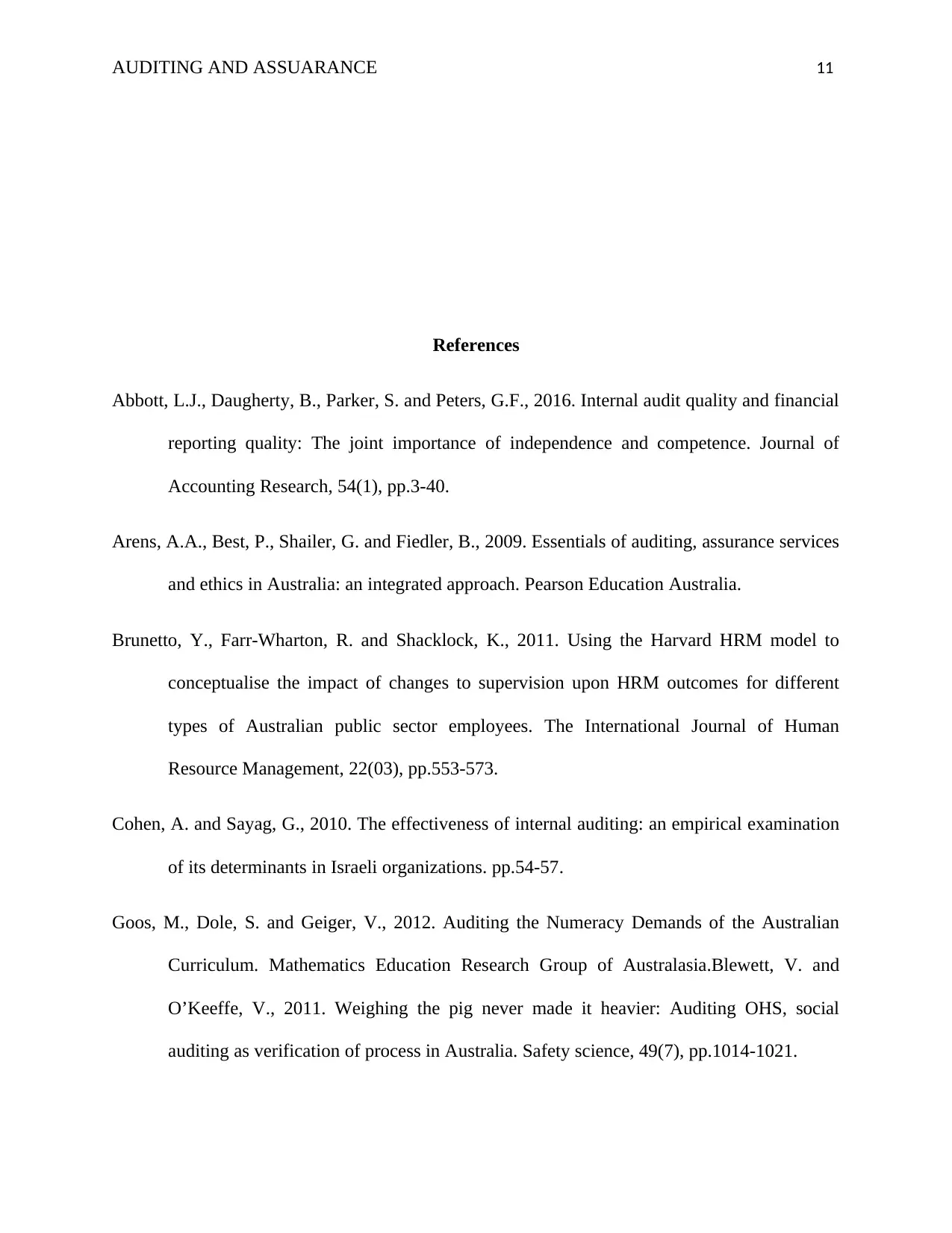
AUDITING AND ASSUARANCE 11
References
Abbott, L.J., Daugherty, B., Parker, S. and Peters, G.F., 2016. Internal audit quality and financial
reporting quality: The joint importance of independence and competence. Journal of
Accounting Research, 54(1), pp.3-40.
Arens, A.A., Best, P., Shailer, G. and Fiedler, B., 2009. Essentials of auditing, assurance services
and ethics in Australia: an integrated approach. Pearson Education Australia.
Brunetto, Y., Farr-Wharton, R. and Shacklock, K., 2011. Using the Harvard HRM model to
conceptualise the impact of changes to supervision upon HRM outcomes for different
types of Australian public sector employees. The International Journal of Human
Resource Management, 22(03), pp.553-573.
Cohen, A. and Sayag, G., 2010. The effectiveness of internal auditing: an empirical examination
of its determinants in Israeli organizations. pp.54-57.
Goos, M., Dole, S. and Geiger, V., 2012. Auditing the Numeracy Demands of the Australian
Curriculum. Mathematics Education Research Group of Australasia.Blewett, V. and
O’Keeffe, V., 2011. Weighing the pig never made it heavier: Auditing OHS, social
auditing as verification of process in Australia. Safety science, 49(7), pp.1014-1021.
References
Abbott, L.J., Daugherty, B., Parker, S. and Peters, G.F., 2016. Internal audit quality and financial
reporting quality: The joint importance of independence and competence. Journal of
Accounting Research, 54(1), pp.3-40.
Arens, A.A., Best, P., Shailer, G. and Fiedler, B., 2009. Essentials of auditing, assurance services
and ethics in Australia: an integrated approach. Pearson Education Australia.
Brunetto, Y., Farr-Wharton, R. and Shacklock, K., 2011. Using the Harvard HRM model to
conceptualise the impact of changes to supervision upon HRM outcomes for different
types of Australian public sector employees. The International Journal of Human
Resource Management, 22(03), pp.553-573.
Cohen, A. and Sayag, G., 2010. The effectiveness of internal auditing: an empirical examination
of its determinants in Israeli organizations. pp.54-57.
Goos, M., Dole, S. and Geiger, V., 2012. Auditing the Numeracy Demands of the Australian
Curriculum. Mathematics Education Research Group of Australasia.Blewett, V. and
O’Keeffe, V., 2011. Weighing the pig never made it heavier: Auditing OHS, social
auditing as verification of process in Australia. Safety science, 49(7), pp.1014-1021.
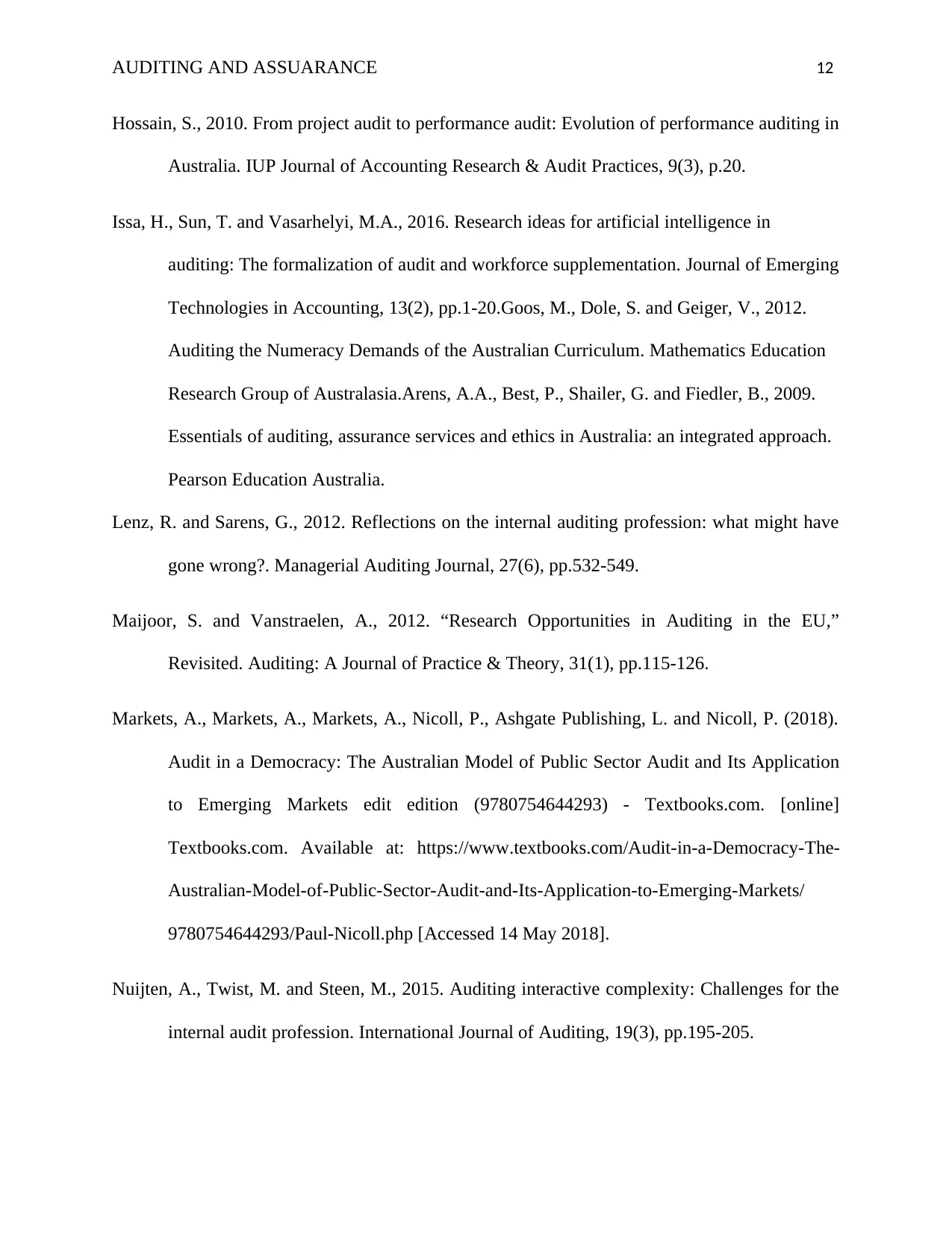
AUDITING AND ASSUARANCE 12
Hossain, S., 2010. From project audit to performance audit: Evolution of performance auditing in
Australia. IUP Journal of Accounting Research & Audit Practices, 9(3), p.20.
Issa, H., Sun, T. and Vasarhelyi, M.A., 2016. Research ideas for artificial intelligence in
auditing: The formalization of audit and workforce supplementation. Journal of Emerging
Technologies in Accounting, 13(2), pp.1-20.Goos, M., Dole, S. and Geiger, V., 2012.
Auditing the Numeracy Demands of the Australian Curriculum. Mathematics Education
Research Group of Australasia.Arens, A.A., Best, P., Shailer, G. and Fiedler, B., 2009.
Essentials of auditing, assurance services and ethics in Australia: an integrated approach.
Pearson Education Australia.
Lenz, R. and Sarens, G., 2012. Reflections on the internal auditing profession: what might have
gone wrong?. Managerial Auditing Journal, 27(6), pp.532-549.
Maijoor, S. and Vanstraelen, A., 2012. “Research Opportunities in Auditing in the EU,”
Revisited. Auditing: A Journal of Practice & Theory, 31(1), pp.115-126.
Markets, A., Markets, A., Markets, A., Nicoll, P., Ashgate Publishing, L. and Nicoll, P. (2018).
Audit in a Democracy: The Australian Model of Public Sector Audit and Its Application
to Emerging Markets edit edition (9780754644293) - Textbooks.com. [online]
Textbooks.com. Available at: https://www.textbooks.com/Audit-in-a-Democracy-The-
Australian-Model-of-Public-Sector-Audit-and-Its-Application-to-Emerging-Markets/
9780754644293/Paul-Nicoll.php [Accessed 14 May 2018].
Nuijten, A., Twist, M. and Steen, M., 2015. Auditing interactive complexity: Challenges for the
internal audit profession. International Journal of Auditing, 19(3), pp.195-205.
Hossain, S., 2010. From project audit to performance audit: Evolution of performance auditing in
Australia. IUP Journal of Accounting Research & Audit Practices, 9(3), p.20.
Issa, H., Sun, T. and Vasarhelyi, M.A., 2016. Research ideas for artificial intelligence in
auditing: The formalization of audit and workforce supplementation. Journal of Emerging
Technologies in Accounting, 13(2), pp.1-20.Goos, M., Dole, S. and Geiger, V., 2012.
Auditing the Numeracy Demands of the Australian Curriculum. Mathematics Education
Research Group of Australasia.Arens, A.A., Best, P., Shailer, G. and Fiedler, B., 2009.
Essentials of auditing, assurance services and ethics in Australia: an integrated approach.
Pearson Education Australia.
Lenz, R. and Sarens, G., 2012. Reflections on the internal auditing profession: what might have
gone wrong?. Managerial Auditing Journal, 27(6), pp.532-549.
Maijoor, S. and Vanstraelen, A., 2012. “Research Opportunities in Auditing in the EU,”
Revisited. Auditing: A Journal of Practice & Theory, 31(1), pp.115-126.
Markets, A., Markets, A., Markets, A., Nicoll, P., Ashgate Publishing, L. and Nicoll, P. (2018).
Audit in a Democracy: The Australian Model of Public Sector Audit and Its Application
to Emerging Markets edit edition (9780754644293) - Textbooks.com. [online]
Textbooks.com. Available at: https://www.textbooks.com/Audit-in-a-Democracy-The-
Australian-Model-of-Public-Sector-Audit-and-Its-Application-to-Emerging-Markets/
9780754644293/Paul-Nicoll.php [Accessed 14 May 2018].
Nuijten, A., Twist, M. and Steen, M., 2015. Auditing interactive complexity: Challenges for the
internal audit profession. International Journal of Auditing, 19(3), pp.195-205.
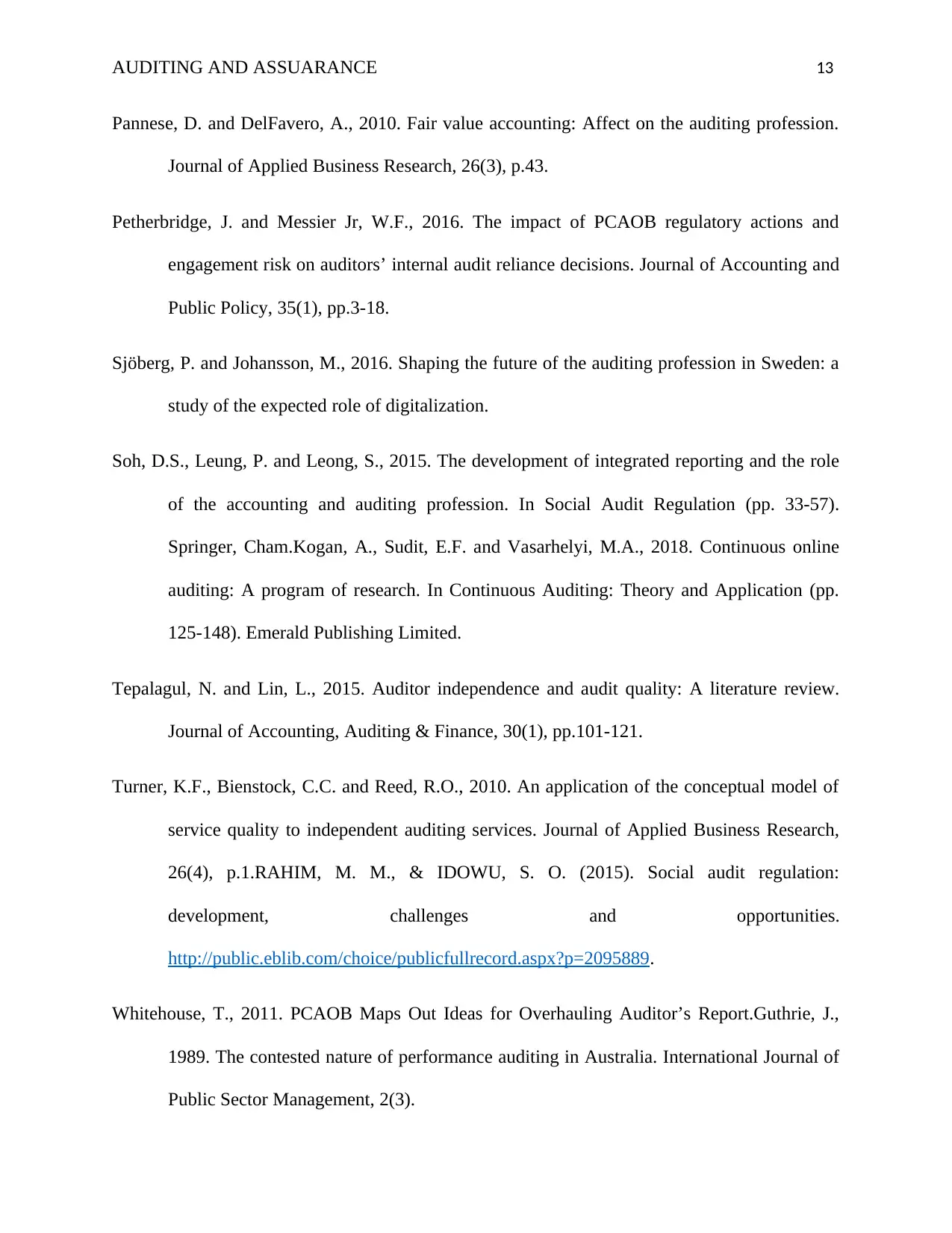
AUDITING AND ASSUARANCE 13
Pannese, D. and DelFavero, A., 2010. Fair value accounting: Affect on the auditing profession.
Journal of Applied Business Research, 26(3), p.43.
Petherbridge, J. and Messier Jr, W.F., 2016. The impact of PCAOB regulatory actions and
engagement risk on auditors’ internal audit reliance decisions. Journal of Accounting and
Public Policy, 35(1), pp.3-18.
Sjöberg, P. and Johansson, M., 2016. Shaping the future of the auditing profession in Sweden: a
study of the expected role of digitalization.
Soh, D.S., Leung, P. and Leong, S., 2015. The development of integrated reporting and the role
of the accounting and auditing profession. In Social Audit Regulation (pp. 33-57).
Springer, Cham.Kogan, A., Sudit, E.F. and Vasarhelyi, M.A., 2018. Continuous online
auditing: A program of research. In Continuous Auditing: Theory and Application (pp.
125-148). Emerald Publishing Limited.
Tepalagul, N. and Lin, L., 2015. Auditor independence and audit quality: A literature review.
Journal of Accounting, Auditing & Finance, 30(1), pp.101-121.
Turner, K.F., Bienstock, C.C. and Reed, R.O., 2010. An application of the conceptual model of
service quality to independent auditing services. Journal of Applied Business Research,
26(4), p.1.RAHIM, M. M., & IDOWU, S. O. (2015). Social audit regulation:
development, challenges and opportunities.
http://public.eblib.com/choice/publicfullrecord.aspx?p=2095889.
Whitehouse, T., 2011. PCAOB Maps Out Ideas for Overhauling Auditor’s Report.Guthrie, J.,
1989. The contested nature of performance auditing in Australia. International Journal of
Public Sector Management, 2(3).
Pannese, D. and DelFavero, A., 2010. Fair value accounting: Affect on the auditing profession.
Journal of Applied Business Research, 26(3), p.43.
Petherbridge, J. and Messier Jr, W.F., 2016. The impact of PCAOB regulatory actions and
engagement risk on auditors’ internal audit reliance decisions. Journal of Accounting and
Public Policy, 35(1), pp.3-18.
Sjöberg, P. and Johansson, M., 2016. Shaping the future of the auditing profession in Sweden: a
study of the expected role of digitalization.
Soh, D.S., Leung, P. and Leong, S., 2015. The development of integrated reporting and the role
of the accounting and auditing profession. In Social Audit Regulation (pp. 33-57).
Springer, Cham.Kogan, A., Sudit, E.F. and Vasarhelyi, M.A., 2018. Continuous online
auditing: A program of research. In Continuous Auditing: Theory and Application (pp.
125-148). Emerald Publishing Limited.
Tepalagul, N. and Lin, L., 2015. Auditor independence and audit quality: A literature review.
Journal of Accounting, Auditing & Finance, 30(1), pp.101-121.
Turner, K.F., Bienstock, C.C. and Reed, R.O., 2010. An application of the conceptual model of
service quality to independent auditing services. Journal of Applied Business Research,
26(4), p.1.RAHIM, M. M., & IDOWU, S. O. (2015). Social audit regulation:
development, challenges and opportunities.
http://public.eblib.com/choice/publicfullrecord.aspx?p=2095889.
Whitehouse, T., 2011. PCAOB Maps Out Ideas for Overhauling Auditor’s Report.Guthrie, J.,
1989. The contested nature of performance auditing in Australia. International Journal of
Public Sector Management, 2(3).
Paraphrase This Document
Need a fresh take? Get an instant paraphrase of this document with our AI Paraphraser
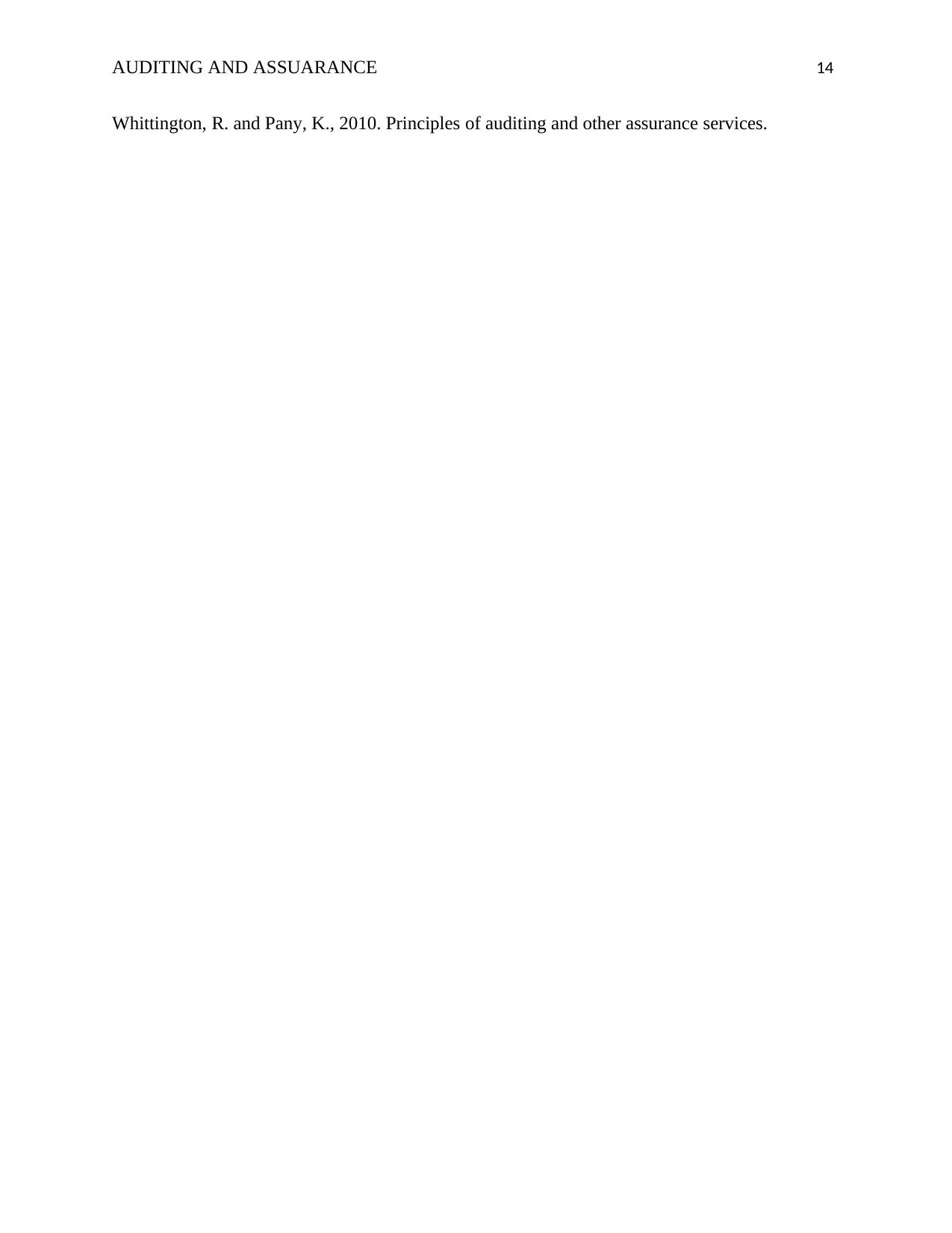
AUDITING AND ASSUARANCE 14
Whittington, R. and Pany, K., 2010. Principles of auditing and other assurance services.
Whittington, R. and Pany, K., 2010. Principles of auditing and other assurance services.
1 out of 14
Related Documents
Your All-in-One AI-Powered Toolkit for Academic Success.
+13062052269
info@desklib.com
Available 24*7 on WhatsApp / Email
![[object Object]](/_next/static/media/star-bottom.7253800d.svg)
Unlock your academic potential
© 2024 | Zucol Services PVT LTD | All rights reserved.





